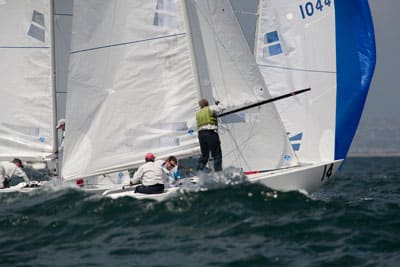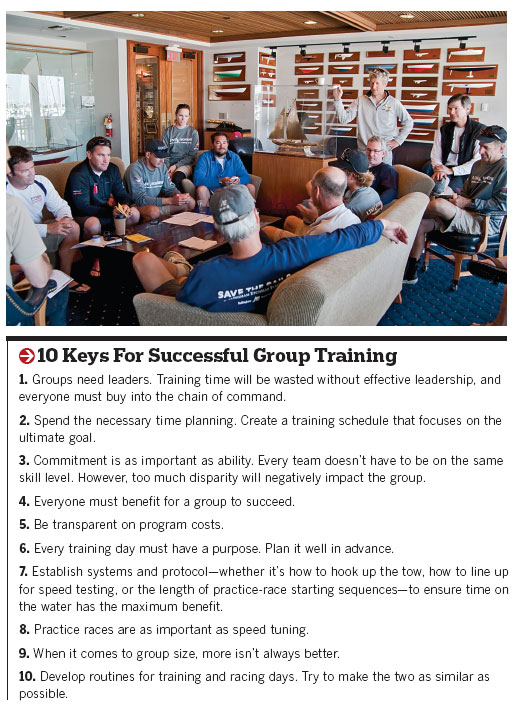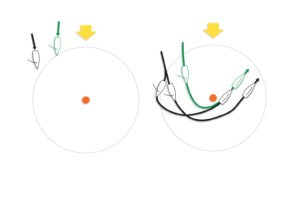
The Value of a Group Effort
The member lounge in the San Diego YC is typically the site of quiet conversations or restful reading. Last spring, it served as Ground Zero for five teams taking steps to excel in the 2011 Etchells World Championship.
The genesis for the group was earlier in the year when Bill Hardesty, who won the Worlds in 2008, started to focus his efforts on winning another title. I had the good fortune of joining Bill for this campaign, and I saw firsthand how he integrated a group of sailors and expert coach Ed Adams, and how everyone benefitted.
While the purpose of our group was to be prepared to compete in the Worlds, our goal was really to be our very best for one week. It could have been any event. As with everything, what you put in controls what you get out. By working as a group, the end result was a cheaper and more effective effort than a one-on-one relationship between a coach and a single team.
One early key to the program’s success was establishing a routine. At our morning meeting we would discuss the goals of the day. On the water, Ed would lead us toward fulfilling these goals. The afternoon debrief included observations, video, photos, and the plan for the next day. During a four-month period, we had 15 days of training and 12 days of competition. All of it was at the Worlds venue. The routine never varied.
Ed was there for 18 of those days. While we were able to move the program forward without him, we always got more accomplished with him present. We were more focused, more organized, and the days were often longer.
“There is no magic to this process,” Adams said. “Just make every hour count. Get comfortable and confident in your sails and settings. Identify weaknesses, whether it is with speed, tactics, strategy, or communications, and come up with solutions. Review each day thoroughly so the lessons become instinctive.”
To maximize training time, we developed plans for things as trivial as picking up the towline to get out to the course, and getting our sails ready. Once we arrived at the training location, every boat had to be ready to sail. We didn’t tolerate stragglers, and it soon became a test to see who would be ready first. Each boat carried a handheld radio to expedite communication. And while not every team in our group was at our level, each was fast enough to win a race at a major regatta. Everyone had qualified for the Worlds, and they were all committed to the process.
It’s easy to get consumed by speed testing. It’s a vital variable, but it’s one of many. There were days we tested sails and other days when we tested rig tune. But nearly every training day on the water also included practice races. It’s one thing to be fast when tuning, but it is much harder to carry the same pace into a race. Settings that work in a coordinated tuning line-up might not work as well when boats are tight off the start line. And the distraction of competition affects concentration.
John Pedlow had worked with Bill and Ed during the lead up to the 2008 regatta, and was back again for the 2011 Worlds. “Bill runs a tight program and served as a good role model for the rest of us,” said Pedlow. “Ed has a no-nonsense approach and is not shy about giving very direct feedback when you need it. We would sort of cringe when the coach boat approached us during a tuning leg, knowing that something wasn’t right on the boat. Then we would fix it and go a little faster.”
By pooling the resources of five teams, we were able to hire the best coach we could find. Ed is a two-time Rolex Yachtsman of the Year, a Star and Laser Masters world champion, and an accomplished coach with an amazing eye for detail. For example, during one group tuning session, we moved our mast butt 5 mm back while Ed was helping another boat. When we lined up again, Ed noticed our main looked flatter down low. Heck, we couldn’t even see the difference, and we were looking for it. He didn’t know we made the change and he spotted it. Credibility is key for a coach. Ed has it.
Having upwards of five boats in our program meant that we were not reliant on who else might be training on any given day. We always had the critical mass needed for tuning, upwind splits, practice starts, and short-course racing. We knew each other, and we all knew how to execute each plan. And while not everyone had the same needs, everyone’s needs were met during the course of our practice sessions. Structure and routine ruled.

Over the course of the program, there grew a sense of togetherness. With everyone attending the meetings, speaking openly of their experiences, and respecting each other, tiers were erased. It was not always apparent we were moving forward—relative to each other there wasn’t a tremendous amount of change—but the group was always experiencing their sport at a heightened level as a team.
While our routine was vital, we also tried to manage our energy levels. The additional meeting time before and after made any day on the water quite long. And, we were all balancing our sailing commitment against our other responsibilities. Balanced rest and practice time was an important consideration leading into the Worlds. The activity in the final week at the regatta venue is intoxicating, and can lead to training even harder. But for a nine-race, six-day regatta, with upwind legs in excess of 2 miles, it is also important to be mentally and physically strong throughout the event. We took a couple breaks in the week leading up to the worlds.
Bill had put together a program to win the 81-boat championship, and that is what we did with a day to spare. It was a bit bizarre attending the afternoon debrief the day we clinched the regatta; popping champagne and swimming in the bay seemed more appropriate. But our routine was our routine. What I remember about that meeting was the genuine support that existed in the room. It was as if we had all won the Worlds, not just one boat. And when working with a group training program, that is the ultimate goal.










